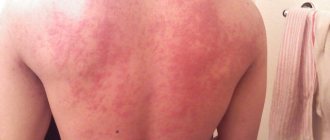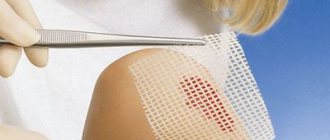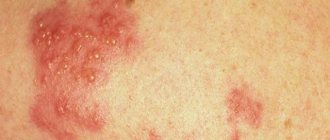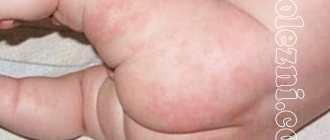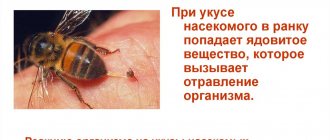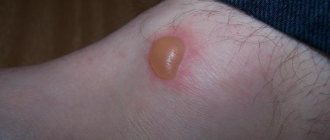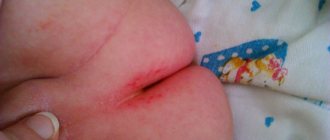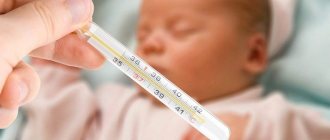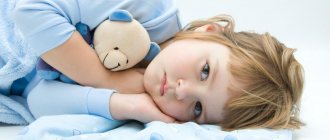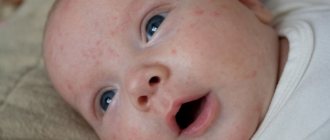What is goose bumps
Goose bumps in a child mean a condition where the surface of the body is covered with pimples at the base of the hair follicles. This is a pilomotor reflex of the body, which occurs as a result of exposure to external and internal factors. Various events (stress, cold, illness) provoke irritation of the peripheral nerves that approach the hairs. The smooth muscles contract and “the hairs stand on end.”
To understand why such a rash is called goose bumps, you should touch a plucked goose. But similar pimples appear in him due to structural features, and in humans - as a reaction to disturbances or irritants. Goose bumps is a popular name; in medicine, a similar condition is called follicular hyperkeratosis.
On a note. This reflex is not unique to humans. Cats and dogs also automatically raise their fur when in danger. Porcupines not only bristle, but also know how to shoot quills at the enemy.
Causes
Natural physiological reasons for the appearance of pimples on the arms, legs and body can be associated not only with cold or severe fear. Something pleasant (for example, waiting to receive a gift, anticipating an interesting trip, listening to your favorite music) may well cause such an interesting effect on the child’s skin. The peculiarity of this manifestation of the pilomotor reflex is that the “goosebumps” pass quickly and do not require any intervention or help.
If “goose bumps” appear in a child regardless of emotions and ambient temperature, then it is quite possible that we are talking about a disease such as hyperkeratosis. With it, the stratum corneum of the skin grows greatly, becomes rough, and ultimately clogs the hair follicles. Most often, goose bumps appear on the forearms, elbows, back of the thighs, butt, and legs (especially the knees).
Quite rarely, goosebumps appear in newborns and infants, since their skin is thinner and more delicate. It is not very often that pimples appear on the face, cheeks, back and stomach. However, this is also possible. Hyperkeratosis never appears on the palms, scalp or heels.
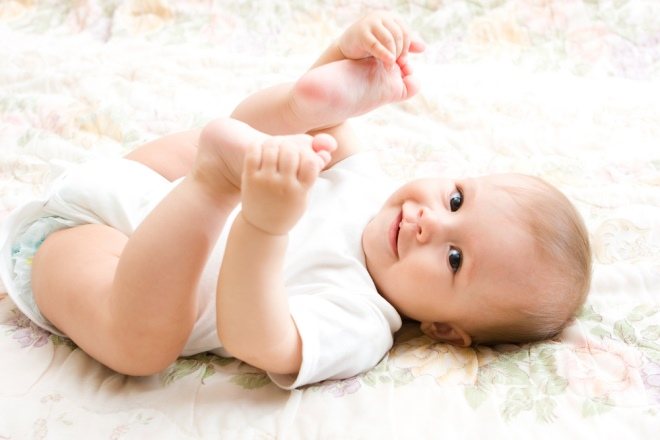
Some babies have pale pink bumps, others are more red. Most often, the rash turns red; if the baby has eaten something wrong, he has an allergy. Under normal conditions, goose bumps do not bother the child, but under the influence of allergens itching may occur.
The affected areas of the skin with hyperkeratosis are very rough and rough to the touch, they look unattractive. This is where all the harm from the disease lies. However, the desire of adults to rid their child of such a skin phenomenon is quite understandable and justified.
Key causes of goose bumps
Blood in the urine of a child - possible causes in infants
Sometimes the occurrence of rashes is a symptom of prolonged contact with the pathogen (low temperatures, stressful situations). In this case, no treatment is required.
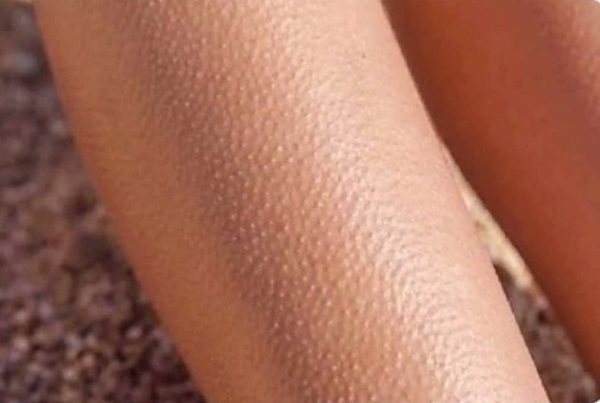
The causes of rashes are varied
If the appearance of pimples is a consequence of the development of pathology, then serious long-term treatment will be required. The causes of goose bumps can be:
- genetic predisposition;
- endocrine system problems;
- dry skin due to external factors;
- metabolic disturbances caused by a lack of vitamins or poor nutrition;
- disruptions in the hormonal system, for example, during adolescence;
- dermatological diseases (allergy, psoriasis, dermatitis);
- poor hygiene and improper care.
To understand the true cause of the problem, you need to see a doctor who will prescribe a series of examinations.
What causes the appearance of goose bumps on the arms, legs, back, and abdomen in children?
The appearance of goose bumps on a child’s body is provoked not only by cold, but also by non-compliance with care rules. As the baby grows, the problem may be difficult to treat. When the first signs appear, the cause is determined and, if necessary, treatment is started.
Goose bumps in children are not uncommon.
What is goose bumps
Goose bumps in a child mean a condition where the surface of the body is covered with pimples at the base of the hair follicles.
This is a pilomotor reflex of the body, which occurs as a result of exposure to external and internal factors.
Various events (stress, cold, illness) provoke irritation of the peripheral nerves that approach the hairs. The smooth muscles contract and “the hairs stand on end.”
To understand why such a rash is called goose bumps, you should touch a plucked goose. But similar pimples appear in him due to structural features, and in humans - as a reaction to disturbances or irritants. Goose bumps is a popular name; in medicine, a similar condition is called follicular hyperkeratosis.
On a note. This reflex is not unique to humans. Cats and dogs also automatically raise their fur when in danger. Porcupines not only bristle, but also know how to shoot quills at the enemy.
Key causes of goose bumps
Blood in the urine of a child - possible causes in infants
Sometimes the occurrence of rashes is a symptom of prolonged contact with the pathogen (low temperatures, stressful situations). In this case, no treatment is required.
The causes of rashes are varied
If the appearance of pimples is a consequence of the development of pathology, then serious long-term treatment will be required. The causes of goose bumps can be:
- genetic predisposition;
- endocrine system problems;
- dry skin due to external factors;
- metabolic disturbances caused by a lack of vitamins or poor nutrition;
- disruptions in the hormonal system, for example, during adolescence;
- dermatological diseases (allergy, psoriasis, dermatitis);
- poor hygiene and improper care.
To understand the true cause of the problem, you need to see a doctor who will prescribe a series of examinations.
Symptoms and places of occurrence
Rough skin on a child’s arms, legs, body - possible causes
The first symptom of goose bumps is dryness. Sometimes not only pimples appear on the body, but also inflammation of the hair follicle occurs. In their place, pimples with pus form.
Rashes rarely appear on the face
On a note. The phenomenon of goose bumps is symmetrical. If the rash appears on one leg, then a similar problem will occur on the second.
Rashes can appear on any part of the body: side, back, tummy, arms, legs, armpits, face, and so on.
Goose bumps in the form of allergies on the arms and legs
Very often, rough orange peel and goose bumps on the arms and legs of a child under one year old are signs of atopic dermatitis. This is an allergic disease.
Moreover, not only contact allergies, but also food or respiratory allergies can cause irritation. It is often difficult to determine the cause. Manifestations can be of a different nature. Some babies develop pimples on their bodies, while others develop red spots. Sometimes areas of irritation appear on specific parts of the body, such as the shoulders.
Goose bumps on the abdomen and back of a child
The cause of the appearance of small pimples on the back and abdomen is high dryness of the skin. Additionally, the problem is provoked by:
- stress or strong emotions;
- lack of hygiene;
- rigid or synthetic clothing;
- lack of vitamins.
If the rash does not go away within a few hours, then you need to see a doctor who will determine the exact cause and prescribe comprehensive treatment.
Goose bumps on the abdomen are most often the result of an allergic reaction.
What does goose bumps mean in children?
Red dots around the eyes of a child - possible causes of the rash
The appearance of goose bumps in children is often a dermatological disease or an atypical reaction of the body. They appear as a result of exposure to negative environmental conditions or when the vital systems of the body are disrupted.
The reasons for the appearance can be absolutely anything. They directly depend on the baby’s lifestyle:
- diet;
- heredity;
- product quality;
- clothing material.
In medicine, such a skin disease is called hyperkeratosis of the epithelial surface.
Features of the disease in children
If the problem appears in an infant, then you should not start treatment right away. It is very important to identify and eliminate the cause of the problem, since after this the unpleasant symptoms will no longer bother the baby. The formation of rashes does not always mean that pathology is developing.
In babies, regeneration processes occur quickly, so old epidermal cells clog the pores. This problem is especially common when the air is too dry or the child is overheated (excessively wrapped).
If you normalize your care regimen and add additional nutrition with moisturizing creams to your daily procedures, the condition will normalize. The small rash will go away on its own.
When the problem does not go away, consult a doctor. He will prescribe additional examinations to understand the true cause. Only a doctor can determine what treatment is needed.
Diagnosis of the condition
The problem is easy to see with the naked eye. A small skin rash (follicular hyperkeratosis) appears in the areas where hair follicles grow. The places where it is localized are the elbows, buttocks, arms, legs, and face. If the rash disappears within a few minutes, then there is no reason to panic.
If the formations do not disappear, then they take a closer look. Dryness and clogged pores are observed where pimples form.
To establish a diagnosis of goose bumps, no additional procedures are needed. To determine the cause, a dermatologist, endocrinologist or other doctors will order additional examinations.
What to do
The sequence of actions to eliminate goosebumps depends on the cause of their appearance. If this is a reaction to a pathogen, then the doctor will give useful recommendations for caring for the baby.
On a note. It is important to keep the room where the baby is kept clean and not allow low humidity levels. If necessary, install a humidifier in the room.
How can a doctor help?
In addition to recommendations for care, the doctor will prescribe treatment if necessary. This applies to cases where goose bumps are caused by pathologies or disorders in a small body:
- For endocrine system disorders, special hormonal drugs are prescribed.
- When an allergic rash appears in the abdominal area, antihistamines are prescribed.
- If goose bumps are the result of exposure to external factors, then vitamin complexes based on groups A, E, D can be prescribed.
To treat skin rashes, special ointments and creams are sometimes prescribed. This should be done by a doctor after making a diagnosis. If the drugs are hormonal, then you cannot smear your face with them.
Skin care at home
To minimize the likelihood of goose bumps appearing on the elbows and other parts of the body, you should take proper care of it. To avoid pimples, follow simple rules:
- A little oil solution of vitamins A and E is added to cosmetic products.
- The approximate amount of water you drink should be about 1.5 liters.
- From the first days of life, the baby is taught the rules of personal hygiene.
- Nutrition should be balanced and correct.
- After each bathing, problem areas of the skin are moisturized with nourishing creams.
- When any skin diseases appear, they are treated quickly and in a timely manner.
Simple rules for caring for delicate baby skin are sometimes the best way to prevent goosebumps.
Proper care will help get rid of dryness
Preventive measures
If your baby has a tendency to develop goose bumps, then you should carefully follow the preventive rules. These will help minimize the likelihood of a problem occurring:
- The baby's body should not be allowed to overheat. It is dressed according to the weather, even in the colder months.
- Places where pimples appear are regularly moisturized (elbows, knees).
- Most often, dehydration leads to dry skin, so carefully monitor the child’s drinking regime.
- A shower is not able to fully cleanse the skin, so they regularly visit the bathhouse or sauna.
- Promptly eliminate any skin diseases that can cause goose bumps.
Most often, goose bumps are a temporary problem. Such states of unrest do not cause concern, the main thing is to exclude the pathogen. If the appearance of goosebumps is a symptom of diseases and disorders of the body systems, then be sure to consult a doctor.
Source: https://kpoxa.info/zdorovie-pitanie/gusinaya-kozha-rebenka-prichiny.html
Symptoms and places of occurrence
Rough skin on a child’s arms, legs, body - possible causes
The first symptom of goose bumps is dryness. Sometimes not only pimples appear on the body, but also inflammation of the hair follicle occurs. In their place, pimples with pus form.
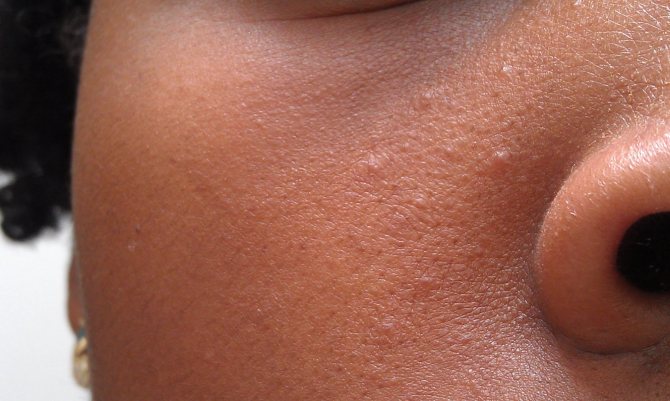
Rashes rarely appear on the face
On a note. The phenomenon of goose bumps is symmetrical. If the rash appears on one leg, then a similar problem will occur on the second.
Rashes can appear on any part of the body: side, back, tummy, arms, legs, armpits, face, and so on.
Goose bumps in the form of allergies on the arms and legs
Very often, rough orange peel and goose bumps on the arms and legs of a child under one year old are signs of atopic dermatitis. This is an allergic disease.
Moreover, not only contact allergies, but also food or respiratory allergies can cause irritation. It is often difficult to determine the cause. Manifestations can be of a different nature. Some babies develop pimples on their bodies, while others develop red spots. Sometimes areas of irritation appear on specific parts of the body, such as the shoulders.
Goose bumps on the abdomen and back of a child
The cause of the appearance of small pimples on the back and abdomen is high dryness of the skin. Additionally, the problem is provoked by:
- stress or strong emotions;
- lack of hygiene;
- rigid or synthetic clothing;
- lack of vitamins.
If the rash does not go away within a few hours, then you need to see a doctor who will determine the exact cause and prescribe comprehensive treatment.
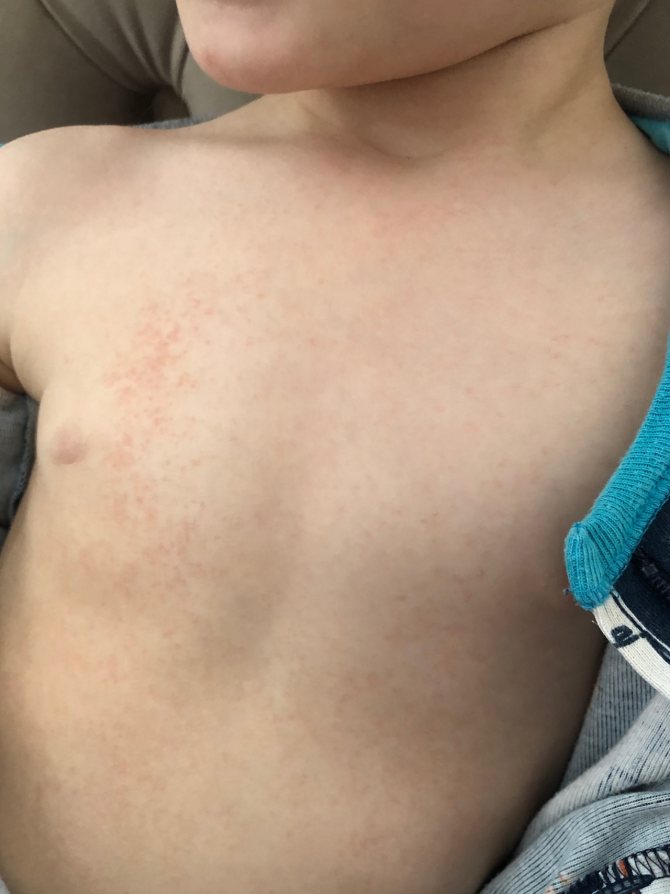
Goose bumps on the abdomen are most often the result of an allergic reaction.
Diseases accompanied by rashes
Any type of rash on the body is a symptom of the disease. They can be very different in appearance. The rash can be papular, pinpoint or, conversely, in the form of large dots or pimples. It comes in a variety of colors, ranging from clear or white to bright red. The characteristics that describe rashes directly depend on their etiology or the illness that they accompany.
Dermatological diseases
Among the diseases of dermatological etiology, the symptoms of which are a variety of rashes, the following can be noted:
- dermatoses (for example, diaper dermatitis);
- psoriasis;
- eczema;
- candidiasis and other diseases of the epidermis.
Almost always, skin diseases are caused by problems with internal organs and systems combined with exposure to external factors. For example, neurodermatitis can be triggered by malfunctions of the nervous and endocrine systems due to decreased immunity. In such a situation, complex therapy is required using medications, and not just ointments or creams.
READ ALSO: Allergies in a child on the legs and rashes on the skin of the body
Psoriasis on the hands of a child
As for psoriasis, at the initial stage it looks like an allergic reaction, but over time the plaques acquire a characteristic appearance. Another name for the disease is lichen planus. Psoriasis and eczema are very rare in children of one month of age. Genetic predisposition to these diseases only after 2 years.
Allergic reaction
One of the main symptoms of allergies is a rash. A negative reaction is the result of taking medications or eating certain foods. Having different shapes and sizes, the rashes can spread throughout the body, including the face, chest, and limbs.
The main characteristic difference between an allergy rash is that it increases in severity when exposed to an allergen and disappears after eliminating the irritant. Another feature is the presence of severe itching.
The most common manifestations of an allergic rash are:
- Hives. Occurs due to foods, medications and temperature factors. Sometimes it is impossible to determine the true cause of hives.
- Atopic dermatitis. It is a papular red rash that, as it develops, merges and becomes crusty. It most often occurs on the face, cheeks and places where the arms and legs are bent. Accompanied by itching.
Atopic dermatitis or eczema
Infectious diseases
Quite often, a rash is a sign of an infectious disease. The most famous of them:
- Chickenpox. The child develops characteristic watery blisters, which dry out and form a crust. They are characterized by itching. The temperature may also rise, but sometimes the disease goes away without it.
- Rubella. The main symptoms are enlarged lymph nodes in the neck and a rash in the form of small red spots or dots that first appear on the face and then move to the neck, shoulders and then spread throughout the body.
- Measles. It appears as round spots and nodules behind the ears, spreading throughout the body. The disease is also accompanied by peeling, pigmentation disorders, fever, conjunctivitis, cough and photophobia.
- Scarlet fever. Initially, the rashes are localized on the cheeks, then move to the limbs, chest and torso. Gradually the rash becomes paler. Scarlet fever is also characterized by a bright red coloration of the palate and tongue.
- Roseola. It starts with an increase in temperature. The fever lasts about three days, after which a pinpoint red rash appears on the body.
- Scabies. It is characterized by a red rash that is very itchy.
Chickenpox symptoms are difficult to confuse with symptoms of another infection Rubella rash Signs of measles Roseola rash
What does goose bumps mean in children?
Red dots around the eyes of a child - possible causes of the rash
The appearance of goose bumps in children is often a dermatological disease or an atypical reaction of the body. They appear as a result of exposure to negative environmental conditions or when the vital systems of the body are disrupted.
The reasons for the appearance can be absolutely anything. They directly depend on the baby’s lifestyle:
- diet;
- heredity;
- product quality;
- clothing material.
In medicine, such a skin disease is called hyperkeratosis of the epithelial surface.
Features of the disease in children
If the problem appears in an infant, then you should not start treatment right away. It is very important to identify and eliminate the cause of the problem, since after this the unpleasant symptoms will no longer bother the baby. The formation of rashes does not always mean that pathology is developing.
In babies, regeneration processes occur quickly, so old epidermal cells clog the pores. This problem is especially common when the air is too dry or the child is overheated (excessively wrapped).
If you normalize your care regimen and add additional nutrition with moisturizing creams to your daily procedures, the condition will normalize. The small rash will go away on its own.
When the problem does not go away, consult a doctor. He will prescribe additional examinations to understand the true cause. Only a doctor can determine what treatment is needed.
How to determine the disease by the location of the rash?
One of the important characteristics of rashes on the body is their localization. It is by what part of the body the spots, dots or pimples are located that one can determine the nature of the problem and the disease that became the root cause of their appearance.
Naturally, this is not the only parameter that is necessary to establish an accurate diagnosis, but it is quite possible to reduce the number of variants of ailments. However, a dermatologist should analyze the factors that caused the appearance of a rash on a particular part of the body and how to treat it in order to avoid serious consequences of self-medication.
Rash on face
In addition to the fact that the appearance of small pimples or spots on the face indicates pathologies in the body, such defects also become an aesthetic problem.
The reasons why the rash affects the facial area can be very diverse:
- Reaction to sunlight. Occurs with prolonged exposure to the sun.
- Allergy. It can be caused by cosmetics, for example, creams containing citrus oils. Food is also often the cause.
- Prickly heat. It is observed in infants one year of age and younger with poor quality skin care.
- Diathesis. It affects children who are breastfed.
- Puberty in adolescents.
- Infectious diseases. Among them are measles, rubella and scarlet fever.
Rashes all over the body
Quite often, the rash affects more than one specific area, but spreads throughout almost the entire body.
Allergic rash in a newborn
If a child is covered with various kinds of rashes, this indicates:
- Erythema toxic. The rash affects 90% of the body. Disappears within 3 days after toxins are removed.
- Newborn acne (we recommend reading: how to treat acne in newborns according to Komarovsky?). Bathing with baby soap, air baths, care and proper nutrition are the solution to this problem.
- Allergic reaction. It can manifest itself as urticaria or contact dermatitis on any part of the body where there was contact with the allergen.
- Infections. If nothing has changed in the child’s diet and habits, then the possible cause of the rash is an infectious disease.
Red dots on arms and legs
As for the rash on the extremities, its main cause is usually an allergy. These allergic manifestations especially affect the hands. They can remain on the skin for a long time if the child experiences constant stress, emotional distress and fatigue. If left untreated, the problem can develop into eczema.
READ ALSO: What causes blackheads to appear on the face: causes and prevention measures
Another reason why your hands and feet may become itchy is a fungal disease (such as psoriasis, scabies or lupus). In cases where there is no rash in other places, a simple miliaria is possible.
Allergic rash on a child's foot
Rash on the stomach
The main factor that can trigger the appearance of a rash on the abdomen is infection, in particular, such well-known diseases as measles, rubella, scarlet fever and chicken pox. With timely and competent treatment, the rash begins to disappear within 3-4 days.
Usually, in addition to the abdomen, the skin is affected in other places. However, if the rash is present exclusively on the abdomen, then contact dermatitis is most likely caused by an allergen coming into contact with the baby's tummy.
Rashes on the head and neck
A rash on the head or neck is most often a result of heat rash. In this case, the child’s thermoregulation should be normalized and proper skin care should be provided. You can also smear the affected areas with ointments and bathe the baby in a series.
Other reasons for the appearance of a rash in these places include:
- chicken pox;
- scabies (we recommend reading: how is scabies treated in children?);
- neonatal pustulosis;
- atopic dermatitis.
Atopic dermatitis
Red dots on the back
The most common causes of red spots on the back and shoulders are:
- allergy;
- prickly heat;
- insect bites;
- measles;
- rubella (we recommend reading: symptoms of rubella in children and photos of the rash);
- scarlet fever.
Two more probable diseases associated with such a location of red dots as the back are:
- Sepsis of bacterial origin. Red pimples quickly spread throughout the body, turning into purulent formations. The disease is accompanied by loss of appetite, vomiting and nausea, and a temperature of up to 38 degrees.
- Meningococcal meningitis. In addition to the rash, the child has subcutaneous hemorrhages on the back, a high fever instantly rises, and constant pain appears in the area where the occipital muscles are located.
Sepsis of bacterial origin
White and colorless rash
In addition to the usual pimples or spots of red and pink color, the rashes may be white or colorless. Most often, the white color of the rash is characteristic of an allergic reaction; in adults, it is characteristic of diseases of infectious etiology. Rashes of this kind on the face indicate normal blockage of the sebaceous glands.
As for the colorless color of the rash, it indicates the presence of:
- vitamin deficiency;
- hormonal imbalance in the body;
- problems in the functioning of the digestive system;
- fungal infection;
- allergies.
Rash that looks like goosebumps
Sometimes a small rash may appear on the baby's skin, which in appearance resembles goosebumps. This sign indicates an allergic reaction caused by hypersensitivity to various irritants, especially drugs. Children with a hereditary predisposition are more susceptible to it.
Diagnosis of the condition
The problem is easy to see with the naked eye. A small skin rash (follicular hyperkeratosis) appears in the areas where hair follicles grow. The places where it is localized are the elbows, buttocks, arms, legs, and face. If the rash disappears within a few minutes, then there is no reason to panic.
If the formations do not disappear, then they take a closer look. Dryness and clogged pores are observed where pimples form.
To establish a diagnosis of goose bumps, no additional procedures are needed. To determine the cause, a dermatologist, endocrinologist or other doctors will order additional examinations.
How to get rid of it?
Most doctors do not recommend treating keratosis pilaris in any way unless it causes particular discomfort to the person. But if pimples on the body cause aesthetic discomfort, they can be dealt with using:
- Some lifestyle changes.
- Using local products to deeply moisturize and nourish the skin.
- Some medications.
- Cosmetological methods.
No method of therapy provides a guarantee of getting rid of keratosis pilaris. It is best for patients with this problem to be periodically observed by a dermatologist, and if pimples appear under the eyes, additionally consult with an ophthalmologist.
In children, keratosis pilaris is usually not treated. Young patients are only recommended to take prophylactic vitamins and regularly apply moisturizing creams to the skin.
General treatment recommendations
When dealing with the manifestations of keratosis pilaris, doctors recommend:
- Avoid injuring the skin with a washcloth, scrub, etc. Such measures will not help remove pimples, but will only injure the epidermis and contribute to more active keratin production.
- Drink enough fluids to avoid skin dehydration.
- Wear loose clothing made from natural materials that will not irritate areas with keratosis.
- Organize a healthy indoor microclimate (especially important during the cold season). Humidity should be maintained at 55% and temperature no higher than 22 °C.
- Follow a proper, healthy and balanced diet.
- To refuse from bad habits.
- Do not use soap that dries out the skin, and avoid too hot water in the shower or bath.
- Take periodic baths with the addition of baking soda, salt or starch.
Usually, following general recommendations helps to improve your skin condition slightly. Such measures prevent further progression of keratosis pilaris.
What medications will help remove it?
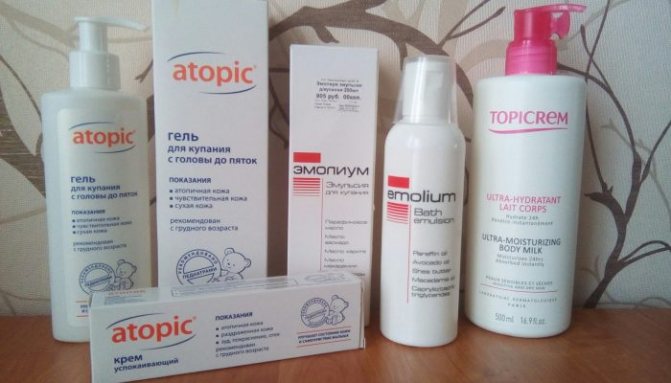
In the treatment of keratosis pilaris, various local drugs can be used, and most often doctors recommend using:
- Special skin moisturizers - emollients.
- Ointments with Vaseline.
- Creams with salicylic acid.
- Creams with lactic acid.
- Local remedies with urea or tretinoin.
- Hormonal agents. Such medications are necessary only when an inflammatory process occurs.
Additionally, patients with keratosis pilaris may be prescribed to take multivitamin preparations or vitamins A, C and E separately.
You should not self-medicate. An experienced cosmetologist will help you select medications for skin care for hyperkeratosis.
Cosmetologist's advice
Sometimes, to get rid of the manifestations of hyperkeratosis, a specialist may recommend a mild superficial peeling. It is quite possible to perform such procedures on your own at home - the necessary solutions for them can be easily purchased in specialized stores or online. Peeling allows you to gently and effectively exfoliate plaques and open hair follicles, but the effect of such a procedure is not very long-lasting. It is worth using acids exclusively in the cold season, and after such exposure, take special care of the skin - provide it with deep hydration and nutrition. This is the only way to prolong the results of peeling.
When particularly large elements of keratosis pilaris appear, a laser resurfacing procedure can be performed.
How to treat with folk remedies?
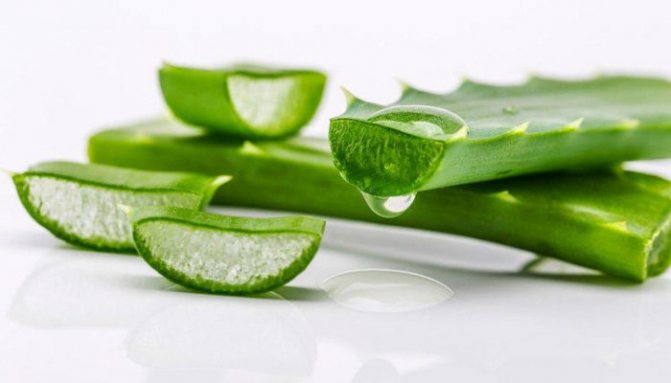
There are quite a few methods for treating skin hyperkeratosis using traditional medicine on the Internet. And some of them can actually help soften and smooth the epidermis. At home you can try the following:
- Aloe. Cut the bottom leaf from a plant that is at least 5 years old. Place in the refrigerator on the vegetable shelf for 3 days, wrapped in newspaper. Then remove the pulp from the leaf, apply it to the problem areas and cover with a piece of gauze. Secure this compress with polyethylene and leave it for several hours, or better yet, overnight. Then wipe the skin with salicylic alcohol. Repeat this procedure 3 times. in Week.
- Starch. Dissolve 0.5 kg of starch in cool water. Pour this solution into a warm bath and take it for 30 minutes. Afterwards, rinse in the shower, pat your skin dry with a towel and be sure to apply moisturizer to problem areas.
- Potatoes. Grind raw potatoes on a fine grater and use to apply compresses to problem areas.
- Apple vinegar. Apply this product to the affected areas, leave for 10 minutes, then rinse with warm water. Next, be sure to lubricate your skin with a nourishing and moisturizing cream. Apple cider vinegar gives a peeling effect.
To date, there is no treatment method that can completely cure keratosis pilaris. Goose bumps on the body can disappear on their own with age, or they can remain on the skin all your life.
What to do
The sequence of actions to eliminate goosebumps depends on the cause of their appearance. If this is a reaction to a pathogen, then the doctor will give useful recommendations for caring for the baby.
On a note. It is important to keep the room where the baby is kept clean and not allow low humidity levels. If necessary, install a humidifier in the room.
How can a doctor help?
In addition to recommendations for care, the doctor will prescribe treatment if necessary. This applies to cases where goose bumps are caused by pathologies or disorders in a small body:
- For endocrine system disorders, special hormonal drugs are prescribed.
- When an allergic rash appears in the abdominal area, antihistamines are prescribed.
- If goose bumps are the result of exposure to external factors, then vitamin complexes based on groups A, E, D can be prescribed.
To treat skin rashes, special ointments and creams are sometimes prescribed. This should be done by a doctor after making a diagnosis. If the drugs are hormonal, then you cannot smear your face with them.
Skin care at home
To minimize the likelihood of goose bumps appearing on the elbows and other parts of the body, you should take proper care of it. To avoid pimples, follow simple rules:
- A little oil solution of vitamins A and E is added to cosmetic products.
- The approximate amount of water you drink should be about 1.5 liters.
- From the first days of life, the baby is taught the rules of personal hygiene.
- Nutrition should be balanced and correct.
- After each bathing, problem areas of the skin are moisturized with nourishing creams.
- When any skin diseases appear, they are treated quickly and in a timely manner.
Simple rules for caring for delicate baby skin are sometimes the best way to prevent goosebumps.
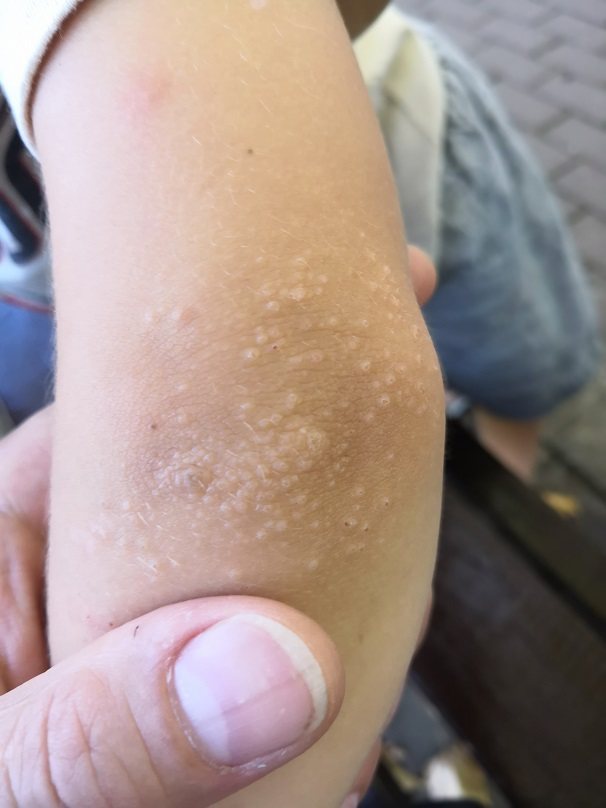
Proper care will help get rid of dryness
Rashes in a newborn
The sensitive skin of newborns is most susceptible to negative external influences. Among the most common cases of rashes on the body of a baby are:
- Prickly heat. It usually appears in a child due to heat as a result of overheating and difficulty sweating. Most often, this type of rash forms on the head, in particular under the hair, on the face, in the folds of the skin, where diaper rash is present. The rashes are blisters and spots that do not cause discomfort to the child (see also: rough spots on the child's body as a symptom). For diaper rash, the time-tested Panthenol Spray with dexpanthenol, a precursor substance to vitamin B5, is also used, stimulating skin regeneration processes. Unlike analogues, which are cosmetics, this is a certified medicinal product and can be used from the first day of a child’s life. It’s easy to apply – just spray it on the skin without rubbing. PanthenolSpray is produced in the European Union, in compliance with high European quality standards; you can recognize the original PanthenolSpray by the smiley face next to the name on the packaging.
- Acne of newborns. Inflamed papules and pustules affect the face, scalp under the hair and neck. They are a consequence of the activation of the sebaceous glands through maternal hormones. Such acne usually does not need to be treated, but quality care and moisturizing of the skin should be provided. They pass without a trace, leaving no scars or pale spots.
- Toxic erythema. It appears in the form of papules and pustules, having a white-yellow color, with a diameter of 1 to 2 mm, surrounded by a red rim. They appear on the second day of life, then gradually go away on their own.
READ ALSO: Three-step care for problem skin: Clinique Anti-Blemish Solutions | Wildberries Style Magazine
Heat rash on the face of a baby
Preventive measures
If your baby has a tendency to develop goose bumps, then you should carefully follow the preventive rules. These will help minimize the likelihood of a problem occurring:
- The baby's body should not be allowed to overheat. It is dressed according to the weather, even in the colder months.
- Places where pimples appear are regularly moisturized (elbows, knees).
- Most often, dehydration leads to dry skin, so carefully monitor the child’s drinking regime.
- A shower is not able to fully cleanse the skin, so they regularly visit the bathhouse or sauna.
- Promptly eliminate any skin diseases that can cause goose bumps.
Most often, goose bumps are a temporary problem. Such states of unrest do not cause concern, the main thing is to exclude the pathogen. If the appearance of goosebumps is a symptom of diseases and disorders of the body systems, then be sure to consult a doctor.
Methods for eliminating pathology
Treatment is selected based on the accompanying signs and causes of the rash. However, doctors often give women certain recommendations that will help get rid of “goosebumps” in a child, regardless of the reason for their development.
- The child should be dressed according to the weather. Otherwise, over-bundling can lead to excessive sweating and clog the pores on the skin, especially on the back.
- Maintaining the required temperature in the nursery, regular ventilation.
- The air in the room where the child is often must be humidified. Dry air can cause a rash.
- Pharmacy products for skin moisturizing. It is necessary to use only natural preparations that do not contain dyes or other chemicals.
If “goose bumps” are formed due to endocrine disorders, the doctor may prescribe hormonal medications. If rashes in the abdominal area are associated with allergic reactions or contact dermatitis, antihistamines are prescribed.
If the problem is caused by external factors and is not a symptom of a disease, vitamin complexes, useful minerals, and trace elements are prescribed. Especially vitamins A, E and D.
You can fight such a rash with the help of special ointments and creams, which should be prescribed by a doctor after examination and diagnosis. It is prohibited to use hormonal drugs on the face.
Symptoms
A dermatologist can determine the presence of follicular hyperkeratosis. In order to detect the presence of pathology, you do not need to undergo special tests or conduct any laboratory tests. The diagnosis is made based on a visual examination by a doctor.
Visually, this type of dermatitis manifests itself as:
- roughness and increased dryness of the skin;
- presence of small red pimples;
- "goose pimples";
- spiny nodules with a red rim at the base of the hair follicle.
The pathology is more aesthetic than medical in nature and does not cause any inconvenience to the patient. The only exceptions are cases when the disease develops against the background of allergic reactions. Then the patient may experience slight itching and redness of the skin.
Causes
Sometimes goose bumps are a physiological reaction to a pathogen. It does not require treatment and occurs in a child with prolonged exposure to cold or emotional excitement. However, in some cases, goose bumps are a sign of pathology. It is formed for a number of reasons:
- metabolic disorders (unbalanced diet, lack of vitamins);
- failure of the endocrine system;
- hormonal imbalance (during adolescence);
- genetic predisposition;
- atopic dermatitis, allergies, psoriasis or skin disease accompanied by dry skin;
- excessive dryness of the epidermis due to external causes (wind, swimming in the salty sea, abundance of household chemicals);
- insufficient hygiene.
Photo of allergic dermatitis on children's legs
When the doctor understands why goosebumps occur, he will be able to choose the right medications. The patient will need to undergo a simple test.
Cosmetic procedures for cleansing goose bumps.
Peeling. Procedures with lactic or fruit acids, sea salt make the skin smoother. The effectiveness will be higher if, after peeling, you make a wrap with seaweed or honey.
Salt peeling. Action: Clears horny scales, makes the skin velvety, soft.
Ingredients: Sea salt - 50–100 g (depending on the area of the goose bump).
Massage oil (grape seed, almond, jojoba) - 1 tbsp. l.
Application: Steam the skin using a compress. Using a massage mitt, grab a pinch of sea salt and add oil. Rub the mixture onto the skin in a circular motion until a pink color appears. At the end of the procedure, wash the mixture off your feet.
Scrubs. Exfoliating agents soften and clean goose bumps, but the use of products with coarse particles is contraindicated. Scrubs with soft polymer components perfectly relieve the effects of excess keratinization. Purchasing sufficient quantities of ingredients and preparing formulations weekly can be time-consuming.
Finished cosmetic products from mass series, but with natural ingredients, save the most precious resource. They introduce the palette of such products to girls who have used them many times and were satisfied with the results:
Masks and wraps. Natural ingredients combined with heat help soften nodules on the skin and saturate it with useful substances.
Wrap with blue clay to get rid of the symptoms of goose bumps. Action: Saturates the skin with moisture, microelements, evens out the relief.
Ingredients: Cosmetic clay - 3–5 tbsp. l. (depending on the size of the affected area).
Water or milk. Orange essential oil - 4-5 drops.
Application: Dilute the clay with milk or warm water to the consistency of sour cream. Add essential oil, stir again. Apply the mixture to areas of the legs with goose bumps, wrap with cling film and a towel. The exposure time of the composition is 35–40 minutes, after which it can be washed off with warm water. Excellent results are obtained by applying the wrap twice a week for 4 weeks.

